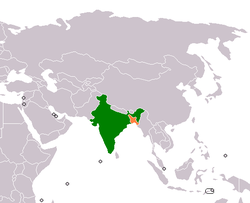بنگلہ دیش بھارت تعلقات
بنگلہ دیش اور بھارت جنوب ایشیائی پڑوسی ہیں۔ تعلقات دوستانہ ہیں، اگرچہ سرحدوں پر کبھی کبھار تنازع ہو جاتا ہے۔6 جون 2015ء کو سرحدی حدود کے تاریخی معاہدے پر دستخط کیے گئے جس سے تعلقات میں ایک نئے دور کا آغاز ہوا اور تعلقات میں تمام تر اشتعال انگیزی بند ہوئی۔[1] دونوں ممالک سارک، بیمسٹک، اورا اور دولت مشترکہ ممالک کے رکن ہیں۔ دونوں ممالک بہت سے ثقافتی تعلقات کا حصہ ہیں۔ خاص طور پر، بنگلہ دیش اور مشرقی ہندوستانی ریاستیں مغربی بنگال اور تریپورہ بنگلہ زبان بولتی ہیں۔ بنگلہ دیش کا ہائی کمشن نئی دہلی میں ہے جب کہ ممبئی اور کولکاتا میں کونسلیٹ قائم ہیں۔ بھارت نے اپنا ہائی کمشن ڈھاکہ میں جب کہ چٹاگانگ میں کونسلیٹ قائم کیا ہوا ہے۔ 1971ء میں، جنگ آزادی بنگلہ دیش نے مشرقی پاکستان اور مغربی پاکستان کو توڑ دیا، بھارت نے دسمبر 1971ء میں مشرقی پاکستان میں مداخلت کی اور مشرقی پاکستان کو پاکستان سے الگ کر کے بنگلہ دیش بنانے میں مدد کی۔ 2014 کے سروے میں، بنگلہ دیشیوں کی 70٪ فیصد عوام نے بھارت کے حق میں اچھی رائے کا اظہار کیا۔[2]
 | |
بھارت |
بنگلادیش |
|---|---|
تاریخ
ترمیمبنگلہ دیش کے ساتھ بھارت کے تعلقات تہذیبی، ثقافتی، سماجی اور معاشی ہیں۔ دونوں ممالک میں بہت سی چیزیں مشترکہ ہیں، مشترکہ تاریخ اور مشترکہ ثقافتی ورثہ، لسانی اور ثقافتی تعلقات، موسیقی سے لگاؤ، ادب اور فنون لطیفہ۔[3]1971 ء میں بنگلہ دیشی جنگ آزادی کے دوران میں دونوں ممالک مضبوط اتحادی تھے۔ 1970ء کی دہائی کیے وسط میں، البتہ، بنگلہ دیش کے اسلامی ممالک سے قریبی تعلقات تنظیم تعاون اسلامی میں شمولیت، ملک بھر میں اسلامی شناخت اور نسلی لسانی گہرے اثرات کے فروغ پانے کی وجہ سے تعلقات میں بگآڑ آیا۔[4][5] سرد جنگ کے دوران میں دونوں ممالک نے الگ الگ اتحادیوں کا ساتھ دیا، جس سے دوطرفہ تعلقات میں مزید سرد مہری آ گئی۔ جنوبی ایشیا میں آزادانہ تجارت کے آغاز کے ساتھ، زیادہ سے زیادہ دو طرفہ اشتراک اور تجارت ہوئی۔ 1996ء میں تاریخی دریائے گنگا کے پانی کے حصول کا معاہدہ ختم کیا گیا تھا۔ بھارت اور بنگلہ دیش انسداد دہشت گردی میں قریبی اسٹریٹجک شراکت دار ہیں۔ وہ جنوبی ایشیا میں بھی سب سے بڑے تجارتی شراکت دار ہیں۔[6]
متنازع علاقے
ترمیممزید دیکھیے
ترمیم| ویکی ذخائر پر بنگلہ دیش بھارت تعلقات سے متعلق سمعی و بصری مواد ملاحظہ کریں۔ |
مزید پڑھیے
ترمیم- Blood, Archer K. (2005)۔ The cruel birth of Bangladesh: Memoirs of an American diplomat. Dhaka: University Press.
- Benkin, Richard L. (2014)۔ A quiet case of ethnic cleansing: The murder of Bangladesh's Hindus. New Delhi: Akshaya Prakashan.
- Dastidar, S. G. (2008)۔ Empire's last casualty: Indian subcontinent's vanishing Hindu and other minorities. Kolkata: Firma KLM.
- Kamra, A. J. (2000)۔ The prolonged partition and its pogroms: Testimonies on violence against Hindus in East Bengal 1946–64.
- تسلیمہ نسرین (2014)۔ Lajja. Gurgaon, Haryana, India : Penguin Books India Pvt. Ltd, 2014.
- Rosser, Yvette Claire. (2004) Indoctrinating Minds: Politics of Education in Bangladesh, New Delhi: Rupa & Co. آئی ایس بی این 8129104318۔
- Mukherji, S. (2000)۔ Subjects, citizens, and refugees: Tragedy in the Chittagong Hill Tracts, 1947–1998. New Delhi: Indian Centre for the Study of Forced Migration.
- Sarkar, Bidyut (1993)۔ Bangladesh 1992 : This is our home : Sample Document of the Plight of our Hindu, Buddhist, Christian and Tribal Minorities in our Islamized Homeland : Pogroms 1987–1992. Bangladesh Minority Hindu, Buddhist, Christian, (and Tribal) Unity Council of North America.
حوالہ جات
ترمیم- ↑ Serajul Quadir (6 جون 2015)۔ "India, Bangladesh sign historic land boundary agreement"۔ Reuters India۔ 2018-12-25 کو اصل سے آرکائیو کیا گیا۔ اخذ شدہ بتاریخ 2018-05-18
- ↑ Pew Research Center۔ "Chapter 4: How Asians View Each Other"۔ Pew Research Center۔ 2018-12-25 کو اصل سے آرکائیو کیا گیا۔ اخذ شدہ بتاریخ 2015-07-22
- ↑ "India-Bangladesh Relations" (PDF)۔ Ministry of External Affairs۔ Government of India۔ 2016-03-04 کو اصل (PDF) سے آرکائیو کیا گیا
- ↑ David Lewis (2011)۔ Bangladesh: Politics, Economy and Civil Society۔ Cambridge University Press۔ ص 31–32۔ ISBN:978-1-139-50257-3۔ 2018-12-25 کو اصل سے آرکائیو کیا گیا۔ اخذ شدہ بتاریخ 2018-05-18۔
By 1974, Pakistan had recognised Bangladesh, and Mujib … began participating in the Organization of the Islamic Conference. This, in turn, brought an end to the early positive phase of Bangladesh's relationship with India … Saudi Arabia to recognise Bangladesh … Zia's new emphasis on building a stronger Islamic identity in place of the earlier emphasis on an ethnolinguistic foundation. This shift also contributed to the creation of a more anti-Indian domestic political climate … Ershad's government continued to build on the positive relation that Zia started building with the United States … Relations with China also continued to remain close, but unlike Zia, Ershad did not make any effort to maintain friendly relations with the Soviet Union.
- ↑ M. Saleem Kidwai (2010)۔ US Policy Towards the Muslim World: Focus on Post 9/11 Period۔ University Press of America۔ ص 240–۔ ISBN:978-0-7618-5158-5۔ 2018-12-25 کو اصل سے آرکائیو کیا گیا۔ اخذ شدہ بتاریخ 2018-05-18
- ↑ "Trade between India and Bangladesh"۔ Business Standard۔ 17 دسمبر 2014۔ 2018-12-25 کو اصل سے آرکائیو کیا گیا۔ اخذ شدہ بتاریخ 2018-05-18